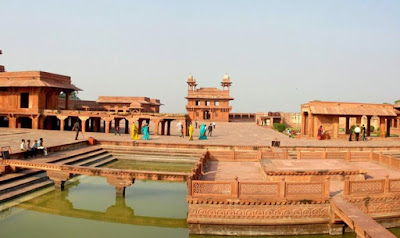1. Taj Mahal
The Taj Mahal
It was built under the aegis of Shah Jahan as a memorial for his beloved wife Arjumand Bano Begum. Her body is enshrined in the tomb at the Taj Mahal.
Construction of the mausoleum was essentially completed in 1643 but work continued on other phases of the project for another 10 years.
The interior chamber is impressively decorated with precious and semiprecious gemstones. The Taj Mahal, for which not only the course of river Yamuna is said to have been diverted but as per interpretation of the Archaeological Survey of India, the Yamuna was incorporated into the garden design for the belief that its one of the rivers of Paradise.
2. Agra Fort
Also called the Red Fort, this structure dates back to the 16th century. It is situated near the gardens of the Taj Mahal. After the First Battle of Panipat in 1526, the Babur stayed in the fort, in the palace of Ibrahim Lodi.
Architects laid the foundation and it was built with bricks in the inner core with sandstone on external surfaces. Some 4,000 builders worked on it daily for eight years, completing it in 1573.
As you go in the fort complex through the Delhi gate, you approach the inner portal. Also called the Hathi Pol this entrance is a magnificent one.Visitors then pass in succession through two of Akbar's gates, the Amar Singh and the Akbari, before finally gaining admittance to the fort proper.
3. Sikandra Fort
The tomb of Akbar is located inside the Sikandra Fort. A beautifully architected structure, it is made of deep red sandstone. The richness of the look and feel never fades away and is timeless. The tomb is located in Agra in a place called Sikandra.
The fort and the tomb are excellent expositions of the combination of Hindu and Muslim architecture. Sikandra, located only 13 km. from the Agra Fort is the last resting place of the Mughal emperor Akbar. Akbar himself planned his own tomb and selected a suitable site for it. Akbar's son Jahangir completed the construction of this pyramidal tomb in 1613.
The beautiful inlay marble & pattern work increases the beauty of this legendry tomb.
4.Mehtab Bagh
This is a garden complex located in the vicnity of the Taj Mahal and Agra Fort. Located in Agra and on the banks of the Yamuna River, Mehtab Bagh is a Charbagh planned garden. The garden complex, square in shape, measures about 300 *300 metres.
The Mehtab Bagh garden was the last of eleven Mughal-built gardens along the Yamuna opposite the Taj Mahal and the Agra Fort.
Its width was identical to that of the rest of the Taj Mahal.
5.Mother Teresa's Missionaries of Charity
The centre is famous for his work of humanity.It has been divided into three chambers. They have a reserved section each for old men and women.He took us to visit the children of the mother teresa Center. Donations can be made. A beautiful work.
Be it the sick, orphaned or the diseased, such helpless people always received a helping hand from her.
6. Fatehpur Sikri
Fatehpur Sikri is a town in the Agra District of Uttar Pradesh, India.The name of the city derives from the village called Sikri which occupied the spot before. An Archaeological Survey of India (ASI) excavation from 1999-2000 indicated that there was a habitation, temples and commercial centres here before Akbar built his capital
Built during the second half of the 16th century by the Emperor Akbar.
Some of the major monuments in Fatehpur Sikri are:
Buland Darwaza: It ranks among the important monuments in the place. This enormous gateway has a height of 54 meters and is largest gateway in the world.
Panch Mahal: The Panch Mahal ranks among the most fascinating buildings in Fatehpur Sikri. It is a five storey building which was meant to be the shelter of the royal ladies and mistresses.
Tomb of Salim Chisti: The tomb of renowned Sufi saint Salim Chisti is located here.
7.Akbar's Tomb
Akbar's tomb is the tomb of the Mughal emperor, Akbar.It is located at Sikandra, in the suburbs of Agra, on the Mathura road (NH2). The tomb's construction was completed by his son prince Salim also called Jahangir.
The entry is through the South gate and is flanked by four minarets. These white minarets are similar to the ones found in the Taj Mahal. The structure is constructed using red sandstone.
The tomb is open from 6 in the morning to 6:30 in the evening. The monument is at its prime beauty throughout the year.
















No comments:
Post a Comment